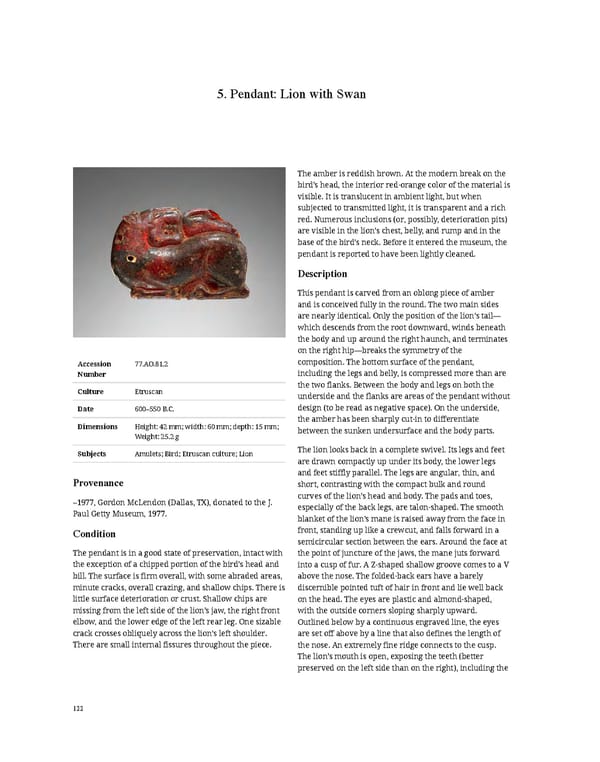5. Pendant: Lion with Swan The amber is reddish brown. At the modern break on the bird’s head, the interior red-orange color of the material is visible. It is translucent in ambient light, but when subjected to transmitted light, it is transparent and a rich red. Numerous inclusions (or, possibly, deterioration pits) are visible in the lion’s chest, belly, and rump and in the base of the bird’s neck. Before it entered the museum, the pendant is reported to have been lightly cleaned. Description This pendant is carved from an oblong piece of amber and is conceived fully in the round. The two main sides are nearly identical. Only the position of the lion’s tail— which descends from the root downward, winds beneath the body and up around the right haunch, and terminates on the right hip—breaks the symmetry of the Accession 77.AO.81.2 composition. The bottom surface of the pendant, Number including the legs and belly, is compressed more than are Culture Etruscan the two flanks. Between the body and legs on both the underside and the flanks are areas of the pendant without Date 600–550 B.C. design (to be read as negative space). On the underside, the amber has been sharply cut-in to differentiate Dimensions Height: 42 mm; width: 60 mm; depth: 15 mm; between the sunken undersurface and the body parts. Weight: 25.2 g Subjects Amulets; Bird; Etruscan culture; Lion The lion looks back in a complete swivel. Its legs and feet are drawn compactly up under its body, the lower legs Provenance and feet stiffly parallel. The legs are angular, thin, and short, contrasting with the compact bulk and round –1977, Gordon McLendon (Dallas, TX), donated to the J. curves of the lion’s head and body. The pads and toes, Paul Getty Museum, 1977. especially of the back legs, are talon-shaped. The smooth blanket of the lion’s mane is raised away from the face in Condition front, standing up like a crewcut, and falls forward in a semicircular section between the ears. Around the face at The pendant is in a good state of preservation, intact with the point of juncture of the jaws, the mane juts forward the exception of a chipped portion of the bird’s head and into a cusp of fur. A Z-shaped shallow groove comes to a V bill. The surface is firm overall, with some abraded areas, above the nose. The folded-back ears have a barely minute cracks, overall crazing, and shallow chips. There is discernible pointed tuft of hair in front and lie well back little surface deterioration or crust. Shallow chips are on the head. The eyes are plastic and almond-shaped, missing from the left side of the lion’s jaw, the right front with the outside corners sloping sharply upward. elbow, and the lower edge of the left rear leg. One sizable Outlined below by a continuous engraved line, the eyes crack crosses obliquely across the lion’s left shoulder. are set off above by a line that also defines the length of There are small internal fissures throughout the piece. the nose. An extremely fine ridge connects to the cusp. The lion’s mouth is open, exposing the teeth (better preserved on the left side than on the right), including the 122
 Ancient Carved Ambers in the J. Paul Getty Museum Page 131 Page 133
Ancient Carved Ambers in the J. Paul Getty Museum Page 131 Page 133